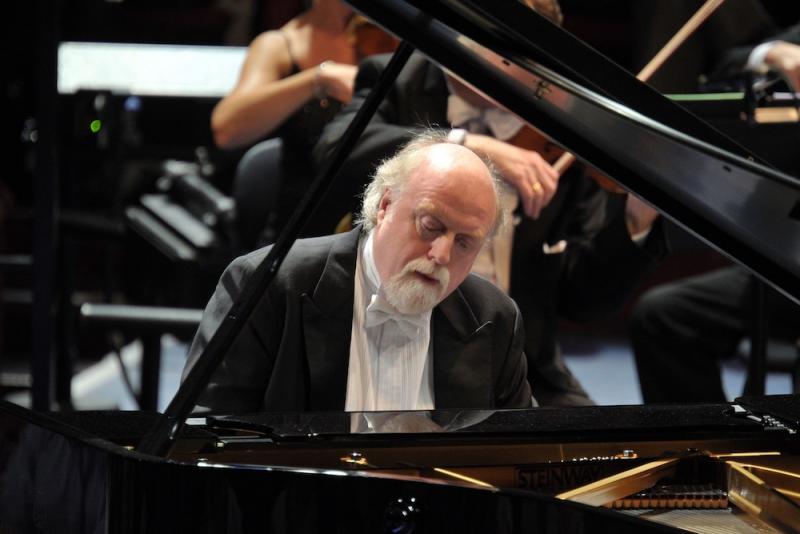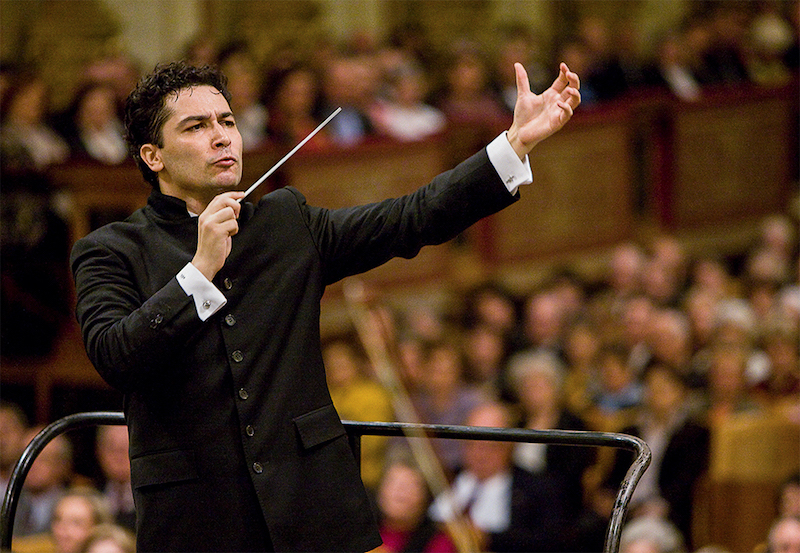Donohoe, LPO, Orozco-Estrada, RFH review – wit aplenty in rare Stravinsky | reviews, news & interviews
Donohoe, LPO, Orozco-Estrada, RFH review – wit aplenty in rare Stravinsky
Donohoe, LPO, Orozco-Estrada, RFH review – wit aplenty in rare Stravinsky
Creative programming deserved a better audience turn-out

I left this concert a bit depressed, but not because of anything I heard: rather, by the conservatism of London concert-goers. As London orchestras focus on programming the usual wall-to-wall Brahms, Beethoven and Mahler, the LPO was rewarded for their excursion from the well-trodden path by the punters staying away in droves from this imaginative programme.
As part of their Changing Faces: Stravinsky’s Journey year-long season, we heard two works from his 1920s output, paired with older pieces in the same vein of good humour and wit. Weber’s Konzertstück was a direct model for Stravinsky’s light-hearted Capriccio, and Schubert’s Third Symphony is full of youthful liveliness. But if audiences are scared away by the tonal, melodic world of Apollon Musagète then I dread to think of the empty rows in the Festival Hall when they reach Threni and the Aldous Huxley Variations in December.
It would be satisfying to report that those who weren’t there missed the best concert of the season, but unfortunately I can’t. There was some terrific playing, particularly in the second half, but also some fallible moments and dips in energy that were only fully overcome in the final item.
The eminent Peter Donohoe was soloist in both would-be piano concertos, continuing a recent trend I’ve noticed of soloists not contenting themselves with just the one concerto in a night. In Stravinsky’s Capriccio, written in 1929 for the composer himself to play, Donohoe was somewhat more authoritative than in the earlier Weber Konzertstück. He recorded the Stravinsky only last year, with the Hong Kong Philharmonic, and has got properly under the skin of the piece. He found a way of making its mercurial character hang together, whether leading the way with assertive gestures or being the music’s motor, in driving figuration, by taking each mood at face value. The string section was much reduced in size compared with the other pieces, and the scoring has a chamber-like clarity. Flautist Juliette Bausor was particularly effective in dancing her skittish lines around the piano. The Capriccio is not a masterwork, but it is genial and charming and well worth hearing. This, though, was the first time I’d heard it live, and I wonder how long it will be till the next.
The string section was much reduced in size compared with the other pieces, and the scoring has a chamber-like clarity. Flautist Juliette Bausor was particularly effective in dancing her skittish lines around the piano. The Capriccio is not a masterwork, but it is genial and charming and well worth hearing. This, though, was the first time I’d heard it live, and I wonder how long it will be till the next.
The Weber Konzertstück is a more traditional virtuoso vehicle, if unconventionally structured as a single movement, sub-divided into four sections. Here Donohoe’s playing was not flawless but it was exciting, although I didn’t envy him the repeated and finger-shredding triple glissandos. The best bit was the solo piano entrance, where his articulation of a long melody over staccato chords was delightfully weighted. But throughout I had a slight uneasiness about his playing that was banished in the Stravinsky.
While Donohoe took centre stage for these middle items, conductor Andrés Orozco-Estrada (pictured above) was firmly in charge for the rest. In Stravinsky’s Apollon Musagète, the opening number, he did his best to give the music life but the playing felt a bit flat: I felt the orchestra was fighting the acoustic, and that this piece particularly needed a more generous hall. Most effective were the fuller, more resonant passages, such as the noble chordal refrain of the terrific "Variation of Apollo". Leader Pieter Schoeman was very good in his extended solos, and a reassuring presence throughout.
But both conductor and orchestra were at their best in the final piece, Schubert’s Third Symphony. Written when the composer was only 18, and influenced by Haydn, it has a breezy self-confidence that was captured beautifully. Orozco-Estrada was at his most animated here, evincing strong interpretative ideas about the music, such as the sustaining the final clarinet note beyond the rest of the orchestra in the second movement, or taking the helter-skelter last movement very fast and nimble. Principal clarinet Giovanni Punzi found the wit in his several solo moments and timpanist Simon Carrington was suitably crisp. When the symphony finished I’d have happily heard it all over again.
rating
Explore topics
Share this article
The future of Arts Journalism
You can stop theartsdesk.com closing!
We urgently need financing to survive. Our fundraising drive has thus far raised £49,000 but we need to reach £100,000 or we will be forced to close. Please contribute here: https://gofund.me/c3f6033d
And if you can forward this information to anyone who might assist, we’d be grateful.

Subscribe to theartsdesk.com
Thank you for continuing to read our work on theartsdesk.com. For unlimited access to every article in its entirety, including our archive of more than 15,000 pieces, we're asking for £5 per month or £40 per year. We feel it's a very good deal, and hope you do too.
To take a subscription now simply click here.
And if you're looking for that extra gift for a friend or family member, why not treat them to a theartsdesk.com gift subscription?
more Classical music
 Hallé John Adams festival, Bridgewater Hall / RNCM, Manchester review - standing ovations for today's music
From 1980 to 2025 with the West Coast’s pied piper and his eager following
Hallé John Adams festival, Bridgewater Hall / RNCM, Manchester review - standing ovations for today's music
From 1980 to 2025 with the West Coast’s pied piper and his eager following
 Kaploukhii, Greenwich Chamber Orchestra, Cutts, St James's Piccadilly review - promising young pianist
A robust and assertive Beethoven concerto suggests a player to follow
Kaploukhii, Greenwich Chamber Orchestra, Cutts, St James's Piccadilly review - promising young pianist
A robust and assertive Beethoven concerto suggests a player to follow
 Robin Holloway: Music's Odyssey review - lessons in composition
Broad and idiosyncratic survey of classical music is insightful but slightly indigestible
Robin Holloway: Music's Odyssey review - lessons in composition
Broad and idiosyncratic survey of classical music is insightful but slightly indigestible
 Classical CDs: Wolf-pelts, clowns and social realism
British ballet scores, 19th century cello works and contemporary piano etudes
Classical CDs: Wolf-pelts, clowns and social realism
British ballet scores, 19th century cello works and contemporary piano etudes
 Bizet in 150th anniversary year: rich and rare French offerings from Palazzetto Bru Zane
Specialists in French romantic music unveil a treasure trove both live and on disc
Bizet in 150th anniversary year: rich and rare French offerings from Palazzetto Bru Zane
Specialists in French romantic music unveil a treasure trove both live and on disc
 Scottish Chamber Orchestra, Ibragimova, Queen’s Hall, Edinburgh review - rarities, novelties and drumrolls
A pity the SCO didn't pick a better showcase for a shining guest artist
Scottish Chamber Orchestra, Ibragimova, Queen’s Hall, Edinburgh review - rarities, novelties and drumrolls
A pity the SCO didn't pick a better showcase for a shining guest artist
 Kilsby, Parkes, Sinfonia of London, Wilson, Barbican review - string things zing and sing in expert hands
British masterpieces for strings plus other-worldly tenor and horn - and a muscular rarity
Kilsby, Parkes, Sinfonia of London, Wilson, Barbican review - string things zing and sing in expert hands
British masterpieces for strings plus other-worldly tenor and horn - and a muscular rarity
 From Historical to Hip-Hop, Classically Black Music Festival, Kings Place review - a cluster of impressive stars for the future
From quasi-Mozartian elegance to the gritty humour of a kitchen inspection
From Historical to Hip-Hop, Classically Black Music Festival, Kings Place review - a cluster of impressive stars for the future
From quasi-Mozartian elegance to the gritty humour of a kitchen inspection
 Shibe, LSO, Adès, Barbican review - gaudy and glorious new music alongside serene Sibelius
Adès’s passion makes persuasive case for the music he loves, both new and old
Shibe, LSO, Adès, Barbican review - gaudy and glorious new music alongside serene Sibelius
Adès’s passion makes persuasive case for the music he loves, both new and old
 Anja Mittermüller, Richard Fu, Wigmore Hall review - a glorious hall debut
The Austrian mezzo shines - at the age of 22
Anja Mittermüller, Richard Fu, Wigmore Hall review - a glorious hall debut
The Austrian mezzo shines - at the age of 22
 First Person: clarinettist Oliver Pashley on the new horizons of The Hermes Experiment's latest album
Compositions by members of this unusual quartet feature for the first time
First Person: clarinettist Oliver Pashley on the new horizons of The Hermes Experiment's latest album
Compositions by members of this unusual quartet feature for the first time

Add comment